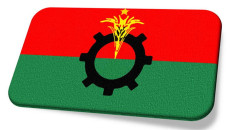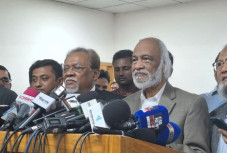
Sylhettoday Desk
02 May, 2025 15:36
Bangladesh-India Trade War: How Political Tensions Are Hurting Business and Economy

Following a prolonged war of words, Bangladesh and India have now entered a phase of retaliatory trade restrictions, leaving business communities on both sides deeply concerned. Traders fear that escalating tensions may severely harm both economies.
Last month, Bangladesh imposed restrictions on land imports of Indian cotton yarn in an effort to protect its local industries from cheaper foreign competition. In response, India abruptly suspended the transshipment facilities it had provided to Bangladesh, citing logistical pressure on its ports and airports as the reason.
The strain in bilateral relations began last August, following the fall of former Prime Minister Sheikh Hasina’s government. Hasina is currently residing in India, while Nobel Laureate Dr. Muhammad Yunus leads an interim government in Bangladesh. The interim administration has accused Hasina of crimes against humanity, money laundering, and corruption, urging India to extradite her. Hasina has denied all allegations, and India has yet to issue an official stance.
Meanwhile, India has frequently expressed concerns over incidents involving Bangladesh’s Hindu minority. After the recent murder of a Hindu community leader, Indian authorities labeled it part of a pattern of minority persecution. Bangladesh, however, insists that such cases are either politically motivated or routine law-and-order issues, not acts of religious oppression. Hindus make up less than 10% of Bangladesh’s 170 million population.
As tensions rise, businesspeople on both sides are counting their losses. Bangladesh’s garment industry, heavily reliant on Indian cotton yarn, has now been forced to import via sea and air, increasing both time and cost. In 2024, India exported $1.6 billion worth of cotton yarn to Bangladesh, a third of which came through land routes.
Before the suspension of transshipment facilities, Bangladeshi garments could reach European and American markets within a week via Indian territory. Now, sea transport can take up to eight weeks. Anis Ahmed, CEO of MGH Group, called the situation “a serious blow to fast-fashion exports.”
As the world’s second-largest apparel exporter after China, Bangladesh exported $38 billion worth of garments in 2024, with over $1 billion of that relying on Indian land and air routes. Limited cargo infrastructure and weak airport capacity complicate direct exports from the country.
During a recent visit to China, Dr. Yunus described Bangladesh as the "only maritime guardian" of India's northeastern region and suggested the area could become a zone for China's economic expansion. Leaders in India’s northeast called his remarks “offensive.”
This region, connected to mainland India through the 20-kilometer-wide Siliguri Corridor—also known as the “Chicken’s Neck”—lies between Nepal and Bangladesh and close to Tibet’s Chumbi Valley. With memories of the 1962 war still vivid, Indian security analysts worry China could target this corridor in future conflicts.
Bangladeshi analysts argue Dr. Yunus’s statement was misinterpreted and aimed to emphasize the importance of regional connectivity. During the same China visit, Bangladesh expressed interest in the $1 billion Teesta River development project, which was welcomed by China. However, Indian experts say the project's proximity to the Siliguri Corridor raises strategic concerns for New Delhi.
The decline in bilateral relations is also affecting everyday citizens. Since Hasina’s ouster, obtaining an Indian visa has become increasingly difficult for Bangladeshis. Visa approval rates have dropped by over 80%. Previously, more than two million Bangladeshis traveled to India annually for healthcare, education, business, and tourism.
The diplomatic standoff over Hasina’s stay in India and the call for her return continues to strain ties. Former Indian Foreign Secretary Shyam Saran warned, “We know the consequences if India were to extradite Hasina. Indian public opinion would not support it.”
Amid these tensions, Indian apparel associations are calling for land-route import bans on Bangladeshi garments. Analysts in Dhaka warn that further barriers would be self-defeating. Economist Debapriya Bhattacharya remarked, “There’s growing demand within Bangladesh to reassess the previous government’s transit and transshipment concessions granted to India.”
India currently transports goods to its northeastern region via Bangladeshi rivers, roads, and railways, significantly reducing transport time and costs. However, trade volume has not grown as expected.
Adding to the diplomatic puzzle, Bangladesh—long distant from Pakistan—has recently signaled a desire to improve ties with Islamabad. Under Hasina’s 15-year rule, relations remained cold. But last month, Pakistan’s Foreign Secretary Amna Baloch visited Dhaka—the first such visit in 15 years. A planned visit by Pakistan’s deputy prime minister was postponed following a deadly attack in Kashmir that heightened India-Pakistan tensions.
On this matter, Shyam Saran stated, “There’s no need to panic over closer Bangladesh-Pakistan ties just yet. But if this is being used to pressure or antagonize India, that would certainly be concerning.”
Public opinion is also shifting, with growing anti-India sentiment in Bangladesh. Indian media outlets are being accused of exaggerating reports of minority persecution and Islamic extremism. This is beginning to fray long-standing people-to-people ties between the two nations.
Analysts warn that unless the situation de-escalates, the economic and trade fallout could be severe.







 সিলেট সিপিবি সাধারণ সম্পাদক সুমন ‘আটক’
সিলেট সিপিবি সাধারণ সম্পাদক সুমন ‘আটক’ 




 IT Lab Solutions Ltd.
IT Lab Solutions Ltd.
আপনার মন্তব্য